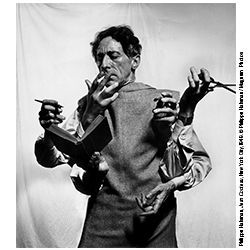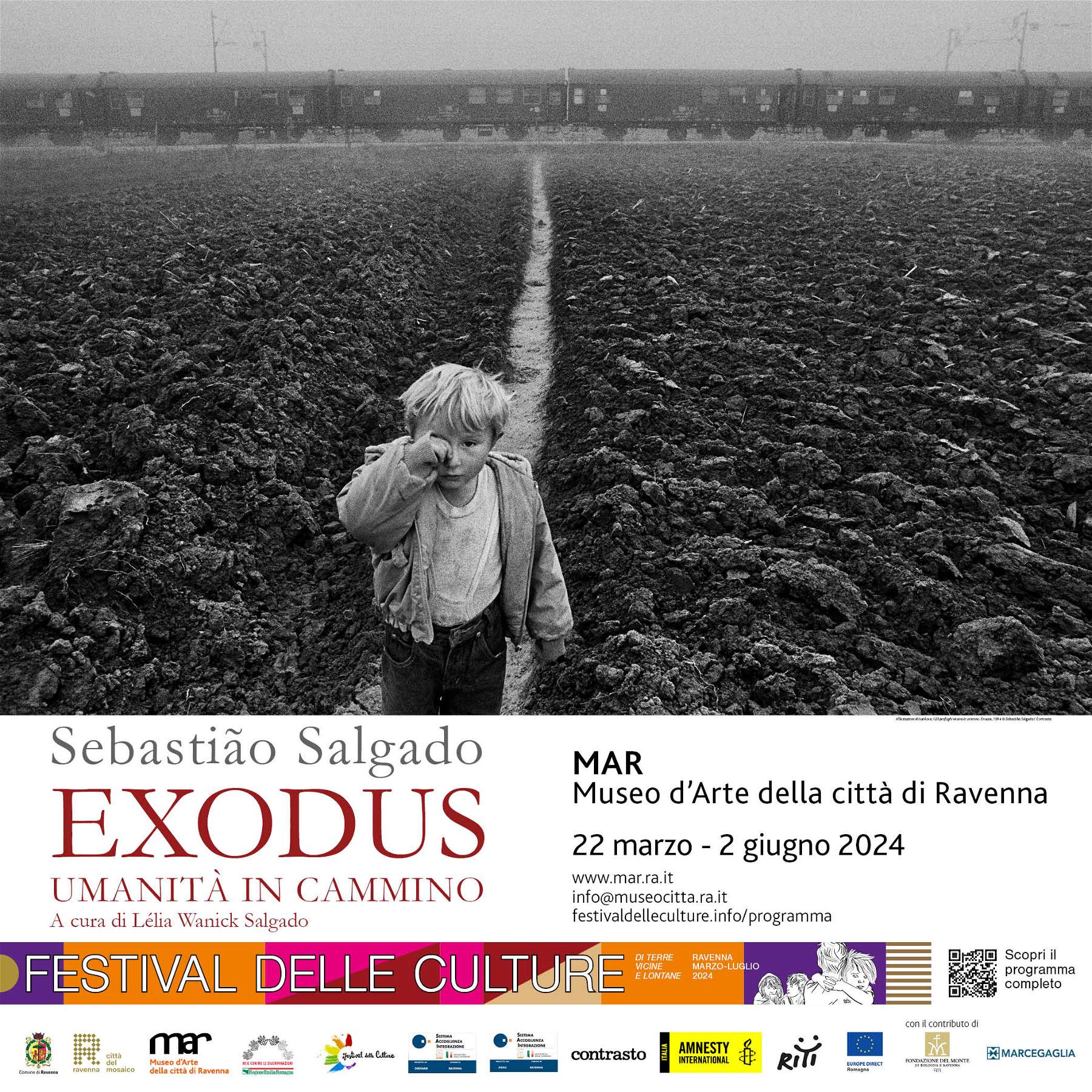Piet Mondrian. Art and works of the founder of Neoplasticism
Piet Mondrian (Amersfoort, 1872 - New York, 1944) was a painter and theorist known for contributing to the founding of Neoplasticism. Artists, with the end of World War I, perceived a progressive decline, also due to the hegemonic loss of European centrality, reflected in the inevitably in works. Neoplasticism is a movement born in the Netherlands in 1917, founded by Piet Mondrian and Theo van Doesburg (Utrecht, 1883 - Davos, 1931) around the magazine De Stijl (“The Style”), a fundamental means of popularizing their ideas. The group consisted of sculptor Georges Vantongerloo (Antwerp, 1886 - Paris, 1965), architects Pieter Oud (Purmerend, 1890 -Wassenaar, 1963), Robert Van’t Hoff (1887 - 1946), Jan Wils (1891 - 1972) and poet Antony Kok (1882 - 1969). They were also joined in 1918 by the famous architect and designer Gerrit Rietveld (Utrecht, 1888-1964), designer of the Schröder House and author of the Red-Blue Chair.
The artists just named are a group of architects, painters and graphic designers whose principles are based on absolute geometric rigor, the adoption of pure geometric forms, with particular interest in the horizontal and vertical line. Underlying the movement is an idea of totalizing art, that is, the integration of art (whether painting, sculpture or architecture) and life. Neoplasticism is thus linked to a universal conception, of interpenetration of space, vital and artistic, in favor of an aesthetic and conceptual rationality. The ultimate meeting point of their ideas is Schröder House, a structure designed by Rietveld, an architectural transposition of Neoplastic principles (absolute rigor, the choice and interpenetration of horizontal and vertical lines).
While the members initially have shared views, some divergences within the group arise from the 1920s, precisely in view of differing interests and needs. Van Doesburg founds the magazine Mecano, in 1921, showing an increasing interest in industrialization and technical progress. Beginning, from this moment, divergences with Mondrian, who did not agree on giving attention to technical innovations, as much as he tended more toward a simple, static tension: an art based solely on line, plane and color, closer, if anything, to the abstract affair of Vasily Kandinsky. It was too rigid and limiting a conception, according to van Doesburg, to use only horizontal and vertical line: in fact, in 1922, the artist tried to break out of that staticity by adopting the diagonal line. Van Doesburg, in opposition to Mondrian’s Compositions, creates in 1924 the Countercompositions, where he resumes pure colors, but with a diagonal pictorial trend, related to the study of movement, therefore more dynamic. Mondrian is so displeased that he leaves the group in 1925. But the contribution he had made to the birth of Neoplasticism had been fundamental and had already marked the history of art.
 |
| Piet Mondrian |
Piet Mondrian: life and the continuity between life and art
Pieter Cornelis Mondriaan Jr., who later passed into art history as Piet Mondrian, was born on March 7, 1872, in Amersfoort, the Netherlands. The son of a painter, he immediately chose to pursue a career in art, also following the example of his uncle, also an artist. His studies, documented roughly between 1892 and 1897, took place in the city of Amsterdam, at the Rijksakademie, the local Academy of Fine Arts, as well as a school for technical experimentation. Seeking greater inspiration for his paintings, Mondrian sought new ideas in the Dutch countryside between 1904 and 1905; he also went to the island of Domburg the following year. The product of those sojourns are the paintings shown in Amsterdam, during an exhibition in 1909, where he presented, at the Stedelijk Museum, a series of works far removed from the neo-plastic outcomes of 1917, rooted on the contrary in Dutch nature.
In 1912 he made a trip to Paris, and it was here that he began signing his name with his new name, Piet Mondrian. He moved to the Montparnasse district, populated by artists of various nationalities and backgrounds.It was as a result of this period that Mondrian abandoned landscape painting in favor of a geometric study of natural forms. During World War I, Mondrian returned to the Netherlands and, once the conflict ended, began working together with van Doesburg, the other founder of De Stijl magazine, which opened in 1917. Their ideas, at first widely shared by both, began to circulate, and the term “Neoplasticism” appeared , designating the art movement already described in the introduction. Mondrian leaves the group in about 1925, but in the 1930s he exhibits with Cercle et Carrè, a Parisian group formed in 1929 and an advocate of new developments inabstract art, with outcomes very close to mystical tendencies. Mondrian is interested in precisely the latter aspect.
In 1931 he joined Abstraction-Création, a French association that gathered a number of artists, such as Kandinsky, El Lissitzky, Willi Baumeister, Anton Pevsner, Georges Vantorgerloo and Mondrian himself, around the conception of non-figurative art. The advance of Nazism forced Mondrian to move, first to London in 1938 and then, like many other European artists, in 1940, following the German invasion of the Netherlands and the fall of Paris, he left Europe forAmerica, where he remained until his death in 1944. Piet continued to pursue neo-plastic conceptions, joining the American Abstract Artists group, a group founded in 1936 in New York that was exhausted in 1941. Among the last experiences that punctuated the Dutchman’s life were his first solo exhibition at the Valentine Dudensing Gallery, in 1942, and the Boogie-woogie series of the same years, an homage to frenetic New York dancing. On February 1, 1944, he passed away, due to pneumonia, at the age of seventy-one.
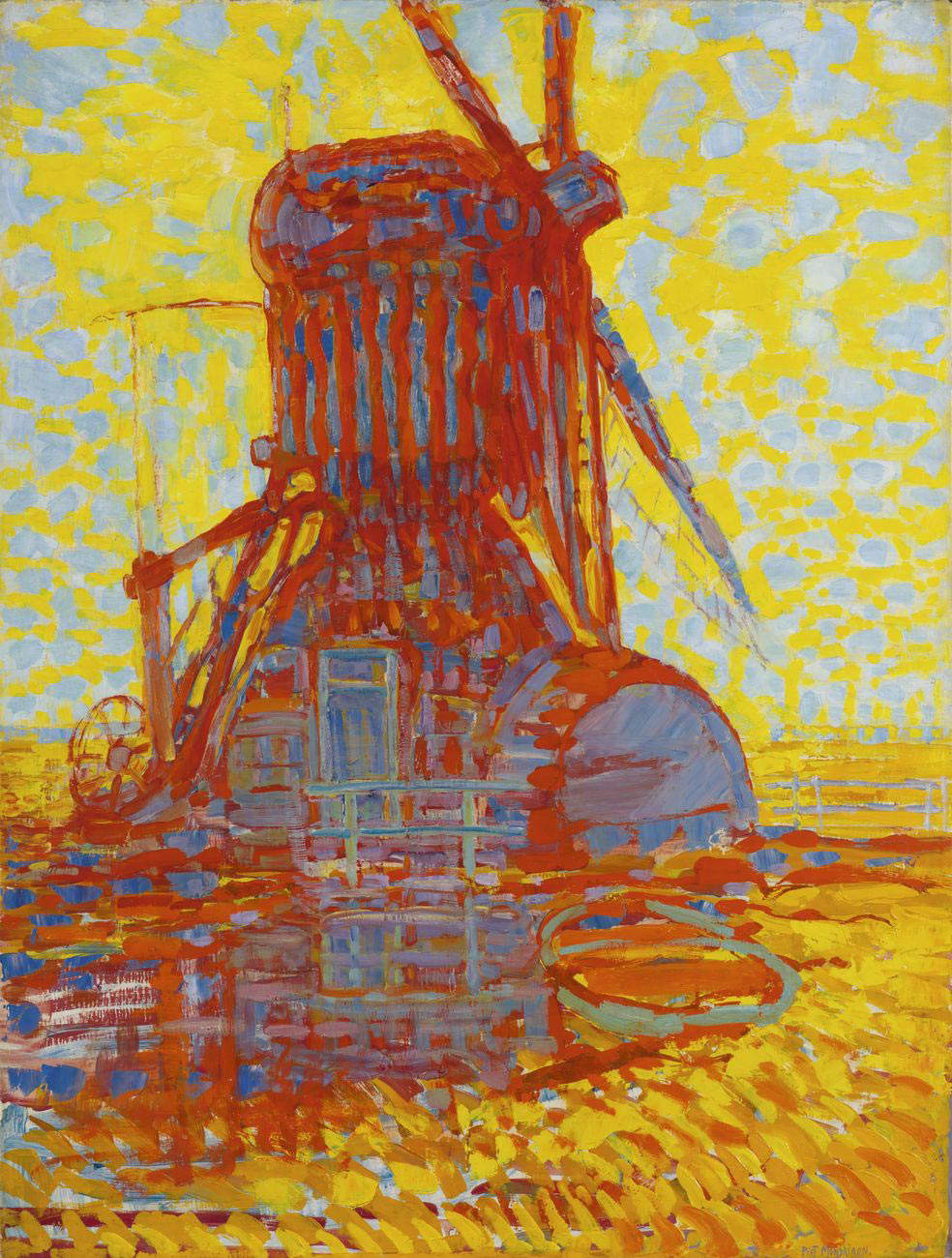 |
| Piet Mondrian, Mill in the Sun (1908; oil on canvas, 114x87 cm; LAia, Gemeentemuseum) |
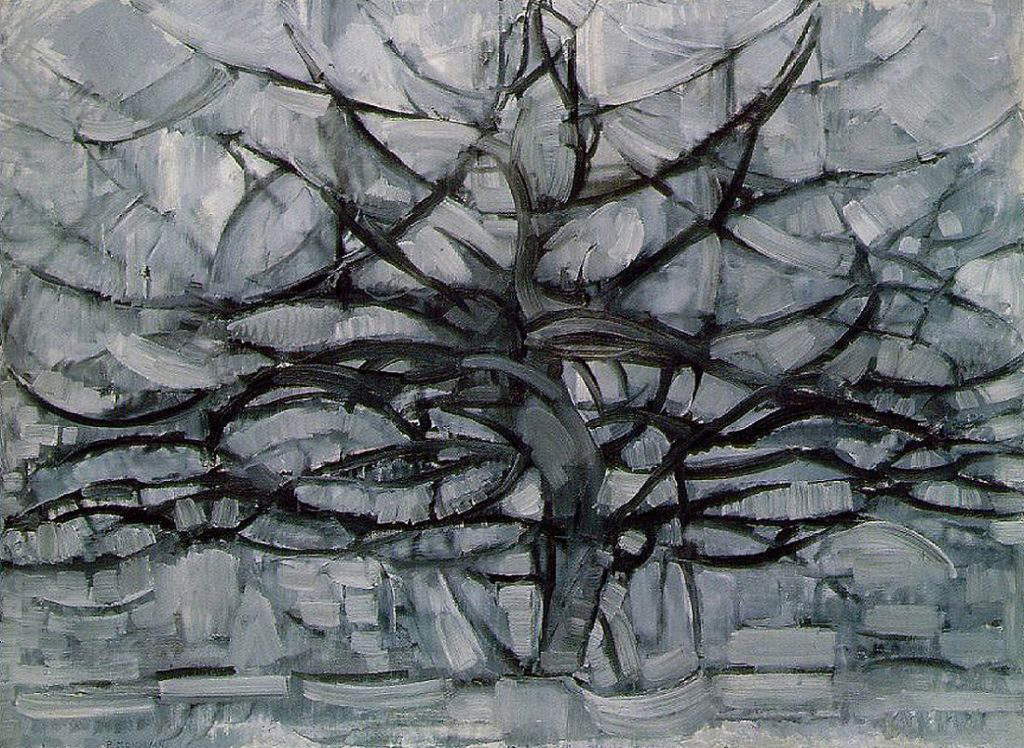 |
| Piet Mondrian, Gray Tree (1911; oil on canvas, 79.7 x 109.1 cm; LAia, Kunstmuseum Den Haag) |
 |
| Piet Mondrian, Composition No. 10 (Pier and Ocean) (1915; oil on canvas, 85 x 108 cm; Otterlo, Kröller-Müller Museum) |
Mondrian’s works: from Realism to Neoplasticism
Mondrian’s artistic story is almost always studied in relation to his experience within the Neoplastic movement. In reality, his starting point is a realist, impressionist-inspired painting, learned through the paintings of the Dutch Hague School(read a detailed discussion of the path that led him from early still lifes to Neoplastic works here). Early in his career, in fact, Mondrian was influenced by the paintings of Vincent Van Gogh (Zundert, 1853 - Auvers-sur-Oise, 1890) seen in Amsterdam, but also by Pointillisme, as well as Nordic Symbolism, particularly Edvard Munch (Løten, 1863 - Oslo, 1944). Some significant works from his early mode of painting are Mill, Twilight: Red Tree , and The Gray Tree. Comparing the three works, some stylistic changes are evident: the lines become simpler and smaller, the color palette becomes colder and colder, with a shift from warm colors such as yellow and red, to a dull blue, to gray. Verisimilitude is also running out. Composition 10 in black and white. Pier and Ocean is the first painting in which Mondrian tries to break with the poetics of his early career. There is an early, timid attempt to geometrize space, as well as a drastic reduction of colors: there are only black and white.
Mondrian’s path reveals debts to Cubism, which the Dutch artist credited with “introducing purely plastic elements and a new technique into painting.” The very movement he founded, Neoplasticism, owes its name to Mondrian’s desire to “express relations plastically through oppositions of color and line,” as he had written in Dialoog over de Nieuwe Beelding (“Dialogue on the New Plastic”), considered the movement’s founding text. Compared to the Cubists, who were still bound to reality, however, the founder of neo-plasticism also wanted to break any subjective view derived from observation of reality. In fact, art, according to Mondrian, is not meant to represent nature, but to express the need for simplicity and essentiality, which according to the Dutch artist is universal. “Painting,” he had to write, “can become evenroa more real, less subjective, much more objective when its possibilities are realized in architecture in such a way that the artist’s skills are combined with the constructive ones.”
In 1919-20 Mondrian completed what was a progressive path, the culmination of which was the Compositions, a series of oil-on-canvas realizations on which he worked until about 1940. Regarding his new way of painting, Mondrian states that “The new spirit destroys the delimited form of aesthetic expression” and again “the appearance of things in nature changes, while reality remains constant.” The artist wants to reduce the representation of reality to the use of the straight line, making use of the primary colors (red, yellow, blue) with the addition of the neutrals, black and white. His Compositions consist of sharp, defined, rigorous geometric lines without realistic references. There is no lack of spiritual component, also present in Kandinsky’s Abstractism of the 1910s, to achieve harmony and a compositional balance.
Before going to America he goes to London, where he still works on Compositions, according to the principles of Neoplasticism. It is in New York that he inaugurates his last series, Boogie-woogie. Inspired by the rhythm of dance, the compositions also become “animated”: the elimination of black color, makes the paintings visually more dynamic; perhaps it is a tribute to the New York atmosphere, decidedly lively compared to the European climate. Broadway Boogie-Woogie, from 1942, preserves the geometric layout of the Compositions, but the lines are fragmented, intertwined with each other, and chromatically bright. Mondrian, if one excludes the change between his formative years and his artistic maturity, never made major changes in his research; however, he remained consistent, until the end, with his theories, perfectly embodying the concept of total art, professed by Neoplasticism.
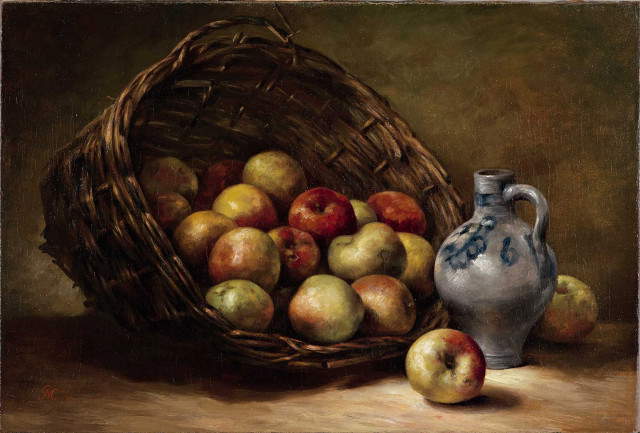 |
| Piet Mondrian, Basket with Apples (November 1891; oil on canvas, 49.5 x 72.8 cm; LAia, Kunstmuseum Den Haag) |
 |
| Piet Mondrian, Red Tree (1909; oil on canvas, 70 x 99 cm; LAia, Kunstmuseum Den Haag) |
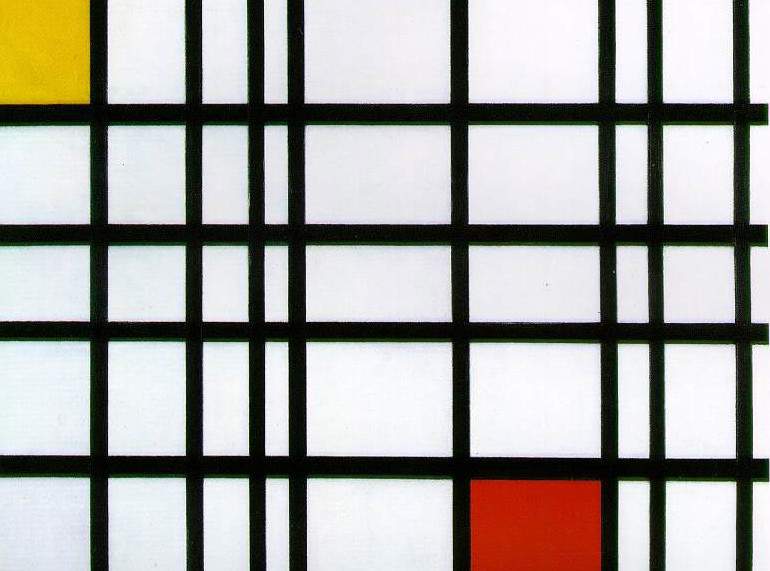 |
| Piet Mondrian, Composition with Yellow, Blue and Red (c. 1937-39; oil on canvas, 62.5x72.7 cm; London, Tate Modern) |
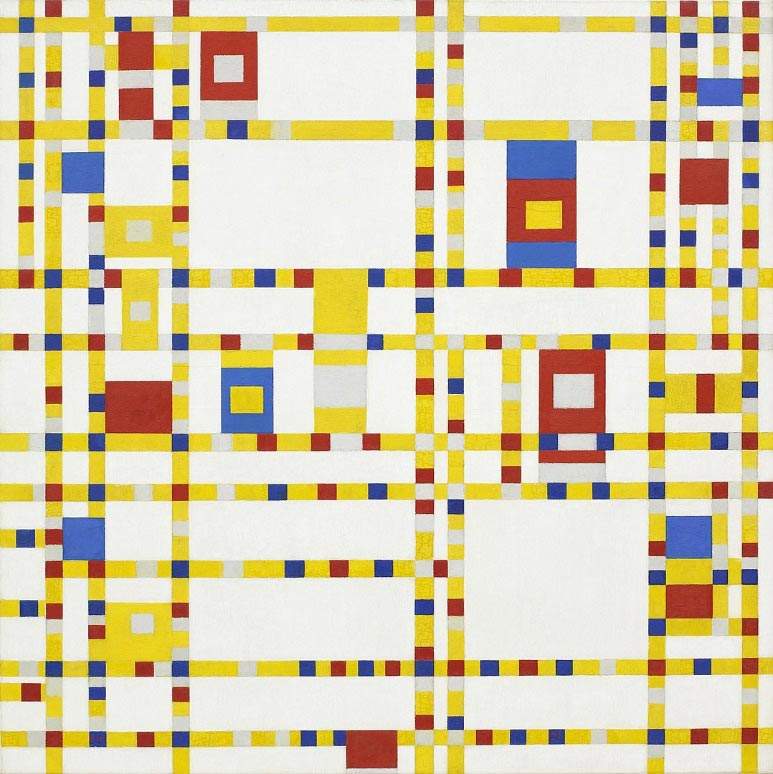 |
| Piet Mondrian, Broadway Boogie-Woogie (1942-43; oil on canvas, 127x127 cm; New York, Museum of Modern Art) |
Where to see Mondrian’s works
Nearly all of Mondrian’s works are abroad, but in Italy there is a painting in Milan from his early period, Lighthouse at Westkapelle (1909-10), which can be seen at the Museo del Novecento; three achievements, preserved at the Peggy Guggenheim Collection in Venice, namely Scaffolding: Study for Tableau III (1914), Ocean 5 (1915) and Composition No. 1 with Gray and Red, from 1939. Abroad, many paintings are kept at the Gemeentemuseum in The Hague, where early works related to figuration can be viewed, such as Mill in the Sun, The Gray Tree, Twilight: Red Tree, as well as works from the De Stijl movement. The paintings are located inside a 1936 building designed by the famous Dutch architect, Petrus Berlage.
Also in the Netherlands, the Kröller-Müller Museum houses some paintings by Mondrian, as well as masterpieces by Van Gogh, Monet, Seurat and Picasso.
Switzerland’s oldest museum, the Kunstmuseum Basel, houses Composition with Red, Yellow and Blue, along with a vast artistic heritage, starting from the medieval period, with important works by Hans Holbein, Peter Paul Rubens, Rembrandt, to thecontemporary age, passing through the works of Segantini, Cézanne, Gauguin, Van Gogh and again Matisse, Picasso, Brancusi, Modigliani, Kandinsky, van Doesburg and many other protagonists of the international art scene.
In America, at the Museum of Modern Art in New York, both works from the 1910s, such as Truncated View of the Mill and View from the Dunes with Beach, and mature works, such as some of the Compositions, up to the last series, Broadway Boogie-Woogie, are preserved.
 |
| Piet Mondrian. Art and works of the founder of Neoplasticism |
Warning: the translation into English of the original Italian article was created using automatic tools. We undertake to review all articles, but we do not guarantee the total absence of inaccuracies in the translation due to the program. You can find the original by clicking on the ITA button. If you find any mistake,please contact us.



